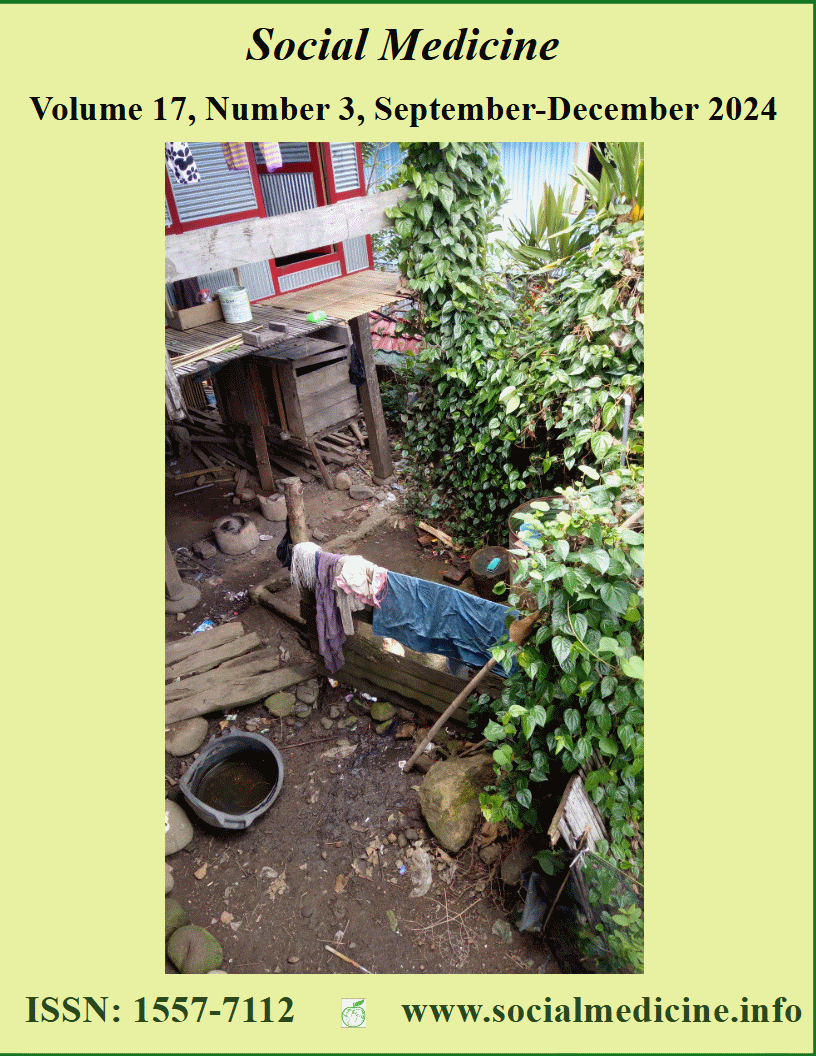Prácticas actuales del personal de salud y aplicabilidad del conjunto de herramientas CLEAR para abordar los determinantes sociales de la salud: un estudio descriptivo transversal en Pakistán
Palabras clave:
Determinantes sociales de la salud, conjunto de herramientas CLEAR, profesionales de la saludResumen
Los determinantes sociales de la salud (DSS) son las condiciones bajo las que las personas nacen, se desarrollan, viven y trabajan. Estas condiciones se crean mediante la distribución de la riqueza, el poder y los recursos a nivel mundial, nacional y local. Los DSS suelen ser responsables de las desigualdades sanitarias y de las variaciones desequilibradas y evitables del estado de salud que se observan dentro de los países y entre ellos. Esteestudio se enfoca en explorar las prácticas actuales del personal sanitario para abordar los DSS y la viabilidad de aplicar un conjunto de herramientas de Community Links EvidencetoActionResearch (Evidencia a la Acción: Estudios dentro de la Comunidad Profesional, CLEAR) diseñadas para facilitar las decisiones clínicas, que apoyan a médicos, enfermeros y demás personal sanitario afín en abordar las causas sociales de la mala salud en la práctica clínica.
Citas
Schramme T. Health as complete well-being: The WHO definition and beyond. Public Health Ethics. 2023 1;16(3):210-218.https://doi.org/10.1093/phe/phad017
Wilkinson RG, Marmot MG, World Health Organization. Centre for Urban Health. The solid facts : social determinants of health. Centre for Urban Health, World Health Organization; 1998. https://iris.who.int/handle/10665/108082
Whitehead M, Dahlgren G. Concepts and principles for tackling social inequities in health: Levelling up Part 2. 2007;(2).
Naz A, Rosenberg E, Andersson N, Labonté R, Andermann A. Health workers who ask about social determinants of health are more likely to report helping patients: mixed-methods study. Canadian Family Physician. 2016 Nov 1;62(11):e684-93.https://www.cfp.ca/content/62/11/e684.short
Andermann A. Taking action on the social determinants of health in clinical practice: a framework for health professionals. Cmaj. 2016;188(17-18):E474-83. DOI: 10.1503/cmaj.160177
Marmot M. Social determinants of health inequalities. Lancet. 2005;365(9464):1099–104. https://doi.org/10.1016/S0140-6736(05)71146-6
Braveman P, Gottlieb L. The social determinants of health: It’s time to consider the causes of the causes. Public Health Rep. 2014;129(SUPPL. 2):19–31. https://doi.org/10.1177/00333549141291S206
WHO Commission on Social Determinants of Health, World Health Organization. Closing the gap in a generation: health equity through action on the social determinants of health: Commission on Social Determinants of Health final report. World Health Organization; 2008.
Marmot M. Fair-Society-Healthy-Lives-Full-Marmot Report. Fair Soc Heal lives. 2013;1-74.
Solar O, Irwin A. A conceptual framework for action on the social determinants of health. WHO Document Production Services; 2010. http://hdl.handle.net/1903/23135
Adler NE, Rehkopf DH. US disparities in health: descriptions, causes, and mechanisms. Annu. Rev. Public Health. 2008 Apr 21;29(1):235-52. https://doi.org/10.1146/annurev.publhealth.29.020907.090852
Krieger N. Embodiment: A conceptual glossary for epidemiology. J Epidemiol Community Health. 2005;59(5):350–5.https://doi.org/10.1136/jech.2004.024562
Marmot M. Health equity in England: The Marmot review 10 years on. BMJ.2020;368:1–4. http://dx.doi.org/doi:10.1136/bmj.m693
Bhutta ZA, Hafeez A, Rizvi A, Ali N, Khan A, Ahmad F, Bhutta S, Hazir T, Zaidi A, Jafarey SN. Reproductive, maternal, newborn, and child health in Pakistan: challenges and opportunities. Lancet. 2013;381(9884):2207-18. doi: 10.1016/S0140-6736(12)61999-0
Barros R, Fox L, Mendonça R. Female-headed households, poverty, and the welfare of children in Urban Brazil. Econ Dev Cult Change. 1997;45(2):231–57.
Lloyd M. Domestic violence and education: Examining the impact of domestic violence on young children, children, and young people and the potential role of schools. Frontiers in psychology. 2018 Nov 13;9:2094. https://doi.org/10.3389/fpsyg.2018.02094
Radell ML, Abo Hamza EG, Daghustani WH, Perveen A, Moustafa AA. The impact of different types of abuse on depression. Depression research and treatment. 2021;2021(1):6654503. https://doi.org/10.1155/2021/6654503
Cullen D, Woodford A, Fein J. Food for thought: a randomized trial of food insecurity screening in the emergency department. Academic pediatrics. 2019 Aug 1;19(6):646-51. https://doi.org/10.1016/j.acap.2018.11.014
Willems SJ, Swinnen W, De Maeseneer JM. The GP’s perception of poverty: A qualitative study. Fam Pract. 2005;22(2):177–83. https://doi.org/10.1093/fampra/cmh724
Cantor T, Anderman A. CLEAR Toolkit advanced pilot study: helping health workers address the social causes of poor health. Can Fam physician. 2017;63(2):S61. https://www.cochranelibrary.com/central/doi/10.1002/central/CN-01409855/full
Andermann A. Taking action on the social determinants of health in clinical practice: A framework for health professionals. Cmaj. 2016;188(17–18):E474–83. https://doi.org/10.1503/cmaj.160177
Artiga S, Hinton E. Beyond health care: the role of social determinants in promoting health and health equity. Kaiser Family Foundation. 2018;10.
Seymour J. The Impact of Public Health Awareness Campaigns on the Awareness and Quality of Palliative Care. J Palliat Med. 2018;21(S1):S-30. https://doi.org/10.1089/jpm.2017.039
Jacobsen GD, Jacobsen KH. Health awareness campaigns and diagnosis rates: Evidence from National Breast Cancer Awareness Month. J Health Econ. 2011;30(1):55–61. http://dx.doi.org/10.1016/j.jhealeco.2010.11.005
Descargas
Publicado
Cómo citar
Número
Sección
Licencia
Derechos de autor 2024 Social Medicine

Esta obra está bajo una licencia internacional Creative Commons Atribución-NoComercial-SinDerivadas 4.0.


